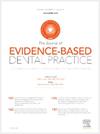EFFICACY OF A REMINERALIZATION AGENT CONTAINING AMMONIUM FLUORIDE SOLUTION AND NANO SOL CALCIUM FLUORIDE FOR TREATMENT OF INITIAL BUCCAL CARIES LESIONS: A SPLIT-MOUTH RANDOMIZED CONTROLLED CLINICAL TRIAL
IF 4
4区 医学
Q1 DENTISTRY, ORAL SURGERY & MEDICINE
引用次数: 0
Abstract
Objective
The aim of the study was to investigate the efficacy of ammonium fluoride solution (AFS) combined with nano sol calcium fluoride (nano-CaF2) for the treatment of active buccal white spot lesions (WSLs) in permanent dentition.
Materials and Methods
Participants with at least 2 WSLs in different quadrants were included in the splitmouth randomized clinical trial. The WSLs meeting the inclusion criteria (n = 60) were randomly assigned into test and control groups. The WSLs in test group (n = 30) received AFS (25,000 ppmF-) and nano-CaF2 (41,400 ppmF-) as a 2-step treatment (Experimental product, Ivoclar Vivadent AG, Schaan, Liechtenstein), while the WSLs in control group (n = 30) received 1-step ammonium fluoride varnish (AFV, 7700 ppmF-, Fluor Protector S, Ivoclar Vivadent AG) treatment. The WSLs were quantitatively assessed using QLF (QrayCam, AIOBIO, Seoul, Republic of Korea) and qualitatively assessed using International Caries Detection and Assessment System (ICDAS-II) and Nyvad criteria at baseline, 1, 6 and 12-months follow-ups. The difference in QLF parameters within each group (Friedman test) and between groups (Wilcoxon test) was analyzed. Binary logistic regression model was used to compare the odds of the WSLs showed regression between the groups based on qualitative assessment.
Results
Overall, 56 WSLs in 21 participants (ages ranged from 14 to 40 years) could be evaluated. Quantitatively, mineral loss (ΔF average and ΔF max), lesion size (WS area) and volume (ΔQ) decreased significantly in test group (P = .001) at 6 and 12 months compared to baseline, whereas no significant difference was found in control group (P > .05). Intergroup comparison showed greater reduction in ΔF average and ΔF max values in the test group compared to control group at 6-month`s follow-up (P = .05). Qualitatively assessed regression rate was higher in test group compared to control group at 6 and 12-months (P < .05).
Conclusion
Caries preventive efficacy of AFS + nano-CF2 was found to be superior to AFV based on both quantitative and qualitative assessment in high caries risk adolescents and young adults.
Clinical Relevance
Two-step treatment with high level of AFS and nano sol CaF2 might be a better option compared to 1-step AFV treatment for the management of WSLs.
含氟化铵溶液和纳米溶胶氟化钙的再矿化剂治疗初期口腔龋病变的疗效:一项裂口随机对照临床试验
目的观察氟化铵溶液(AFS)联合纳米溶胶氟化钙(nano- caf2)治疗恒牙列活动性颊白斑病变的疗效。材料与方法在不同象限至少有2例wsl的受试者纳入裂口随机临床试验。将符合纳入标准的wsl (n = 60)随机分为试验组和对照组。试验组(n = 30)采用AFS (25,000 ppmF-)和纳米caf2 (41,400 ppmF-)两步处理(实验产品,Ivoclar Vivadent AG, Schaan,列支敦士登),对照组(n = 30)采用一步氟化铵清漆(AFV, 7700 ppmF-, fluprotector S, Ivoclar Vivadent AG)处理。在基线、随访1个月、6个月和12个月时,采用QLF (QrayCam, AIOBIO, Seoul, Korea)对wsl进行定量评估,并采用国际龋齿检测和评估系统(ICDAS-II)和Nyvad标准对wsl进行定性评估。分析各组内(Friedman检验)和组间(Wilcoxon检验)QLF参数的差异。在定性评价的基础上,采用二元logistic回归模型比较各组间wsl出现回归的几率。结果21例患者(年龄14 ~ 40岁)共56例wsl得到评价。在数量上,与基线相比,试验组在6个月和12个月时矿物质损失(ΔF平均和ΔF最大)、病变大小(WS面积)和体积(ΔQ)显著下降(P = .001),而对照组无显著差异(P >;. 05)。组间比较显示,随访6个月时,试验组的ΔF平均值和ΔF最大值较对照组降低幅度更大(P = .05)。在6个月和12个月时,试验组的定性评估回归率高于对照组(P <;. 05)。结论通过定量和定性评价,AFS + 纳米cf2对高龋青少年和青壮年的预防效果均优于AFV。与一步AFV治疗相比,高水平AFS和纳米溶胶CaF2两步治疗可能是治疗wsl的更好选择。
本文章由计算机程序翻译,如有差异,请以英文原文为准。
求助全文
约1分钟内获得全文
求助全文
来源期刊

Journal of Evidence-Based Dental Practice
DENTISTRY, ORAL SURGERY & MEDICINE-
CiteScore
6.00
自引率
16.70%
发文量
105
审稿时长
28 days
期刊介绍:
The Journal of Evidence-Based Dental Practice presents timely original articles, as well as reviews of articles on the results and outcomes of clinical procedures and treatment. The Journal advocates the use or rejection of a procedure based on solid, clinical evidence found in literature. The Journal''s dynamic operating principles are explicitness in process and objectives, publication of the highest-quality reviews and original articles, and an emphasis on objectivity.
 求助内容:
求助内容: 应助结果提醒方式:
应助结果提醒方式:


